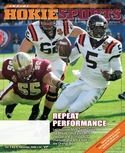Nearly every photo you see in a Virginia Tech game program, on hokiesports.com or in this very magazine comes from Virginia Tech photography coordinator Dave Knachel. Now a 27-year veteran of capturing the excitement of Hokie sports, Knachel has been behind a camera at Tech sporting events since he first stepped on campus in 1981 as a student. He learned the ropes with the school’s student publications before working as a freelance photographer for the precursor to this magazine, the Hokie Huddler. Following a decade of working for local newspapers and moonlighting for Tech, he was hired full-time by the athletics department in 1996 to take pictures of each of Tech’s 21 sports, provide photos to the media and design in-house publications. Here are a few thoughts from the man who documents everything in Hokie imagery:
The digital age has changed everything.
“We used to shoot film, and the day after the game involved mixing chemicals, developing the film, looking through the negatives, deciding which ones to print and then making enlargements. It took money and time. But now, everything is digital so there are no limits and we can shoot a lot more photos. Everything can be done on the computer right after the game is over.
“Before the switch to digital in the fall of 2000, I would take, at most, 360 shots for a big football game. But now, I’ll take about 1,200. With film, at the end of the day after the game, we maybe had a dozen pictures that were available to be used in public. Now, we save about 200 shots per game and we do Web galleries with over 100 pictures.”
So has the Internet.
“The Internet has definitely increased the amount of work that we do, but I think that’s a good thing because no matter what sport you play or are interested in, we’re going to have some images of the events up there for you to see.
“My job, as it is now, didn’t exist before I did it. There was no full-time photographer job, so it’s all just sort of evolved over time. As the needs for images of Tech sports became greater, the position became necessary, and since then, we’ve grown what we do with photography immensely. Some of the numbers are astounding to me. Last year on the Web site, we added 7,468 total images for Tech’s 21 sports combined. Previously, we might have 100 pictures after a football season, and for some of the other sports, hardly any at all.”
Different sports present different challenges.
“I’d say football is the most fun to shoot because it’s a bigger event with more going on around it. I have as much fun during a game watching what the fans are doing and coming up with unique pictures that way as I do shooting the game.
“On the other hand, volleyball is the hardest sport to get great pictures of. You can get decent pictures, but it happens so fast. In football, you can see what’s taking place and refocus as the play happens, but in volleyball, you’ve got to guess where the ball is going or simply get lucky!”
Photographers need to be in the game just like the players.
“Just like the teams I cover, sometimes I have good days and sometimes I have bad days. But the harder you work at it, the more success you’re going to have. A sports photographer is always thinking about what the athletes are going to do and what is going to be the best possible picture. On every play, you sort of choose what your priority is and what you’re going to focus on, so if that happens, you’re in the right spot and you have the right lens on. But sometimes the play can be on the other side of the field and you’ve got nothing. You can put yourself out of position by trying to outthink the game and by guessing the wrong play. No matter how long you do it, you’re always going to wish that you made better decisions and different choices. You’re never going to be in the right place all the time.”
You know a great photo when you see one.
“There have been so many great moments that they sort of blend together, but one photo that stands out is the one I took of Michael Vick on everybody’s shoulders when we finished the 1999 regular season undefeated. That one was used on the first two-page spread in the Sports Illustrated special edition that was done on the team that year. That photo was neat, because a lot of times, people don’t agree on what is and isn’t a great picture. But I loved that one and so did a lot of other people.”
You may think my job is pretty cool; I certainly do.
“I love shooting Tech sports. I feel very fortunate to have a job where, at least some percentage of the time, I’m at the same event that I would be at even if I wasn’t doing it as a job. There are a lot of great people who work here and a lot of great fans who root for the Hokies. I feel good about going the extra mile to provide things for Tech fans because I know they go the extra mile when it comes to supporting Tech athletics.”




